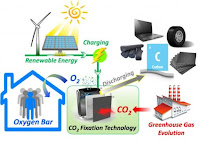Scientists working toward the elusive lithium-air battery discovered an unexpected approach to capturing and storing carbon dioxide away from the atmosphere. Using a design intended for a lithium-CO2 battery, researchers in Japan and China have developed a way to isolate solid carbon dust from gaseous carbon dioxide, with the potential to also separate out oxygen gas through the same method. Their work appears August 9 in Joule, a new interdisciplinary energy journal from Cell Press.
Converting carbon dioxide emissions into other carbon-containing compounds is desirable due to carbon dioxide's contribution to the greenhouse effect and global warming. Examples range from natural processes, such as plants turning CO2 into oxygen and sugars, to human-made ones, such as injecting carbon dioxide into rock formations to be trapped as carbonate minerals.
"The problem with most physical and chemical pathways for CO2 fixation is that their products are gases and liquids that need to be further liquefied or compressed, and that inevitably leads to additional energy consumption and even more CO2 emissions," says senior author Haoshen Zhou of Japan's National Institute of Advanced Industrial Science and Technology and China's Nanjing University. "Instead, we are demonstrating an electrochemical strategy for CO2 fixation that yields solid carbon products, as well as a lithium-CO2 battery that can provide the energy necessary for that process."
The researchers encountered the carbon fixation strategy when they tried to recharge a lithium-CO2 battery prototype. Instead of fully regenerating lithium ions and CO2 from the lithium carbonate and carbon produced during battery discharge, as would have taken place with a reversible Li-CO2 battery, the lithium carbonate decomposed, yielding additional carbon, as well as oxygen gas that was not isolated due to rapid reaction with the battery electrolyte. Typically, this kind of buildup causes physical degradation and reduced functional lifespan for a battery, but instead, the deposition of solid carbon boasts a separate advantage, pointing to a promising approach to fix carbon in a stable and easy-to-dispose-of form.
"What is impressive about this work is the possibility to convert one-third of the CO2 species to carbon with a high theoretical energy efficiency above 70%," says Joule scientific editor Rahul Malik. "Battery architecture is an unforeseen but intriguing way to look at carbon fixation."
Read more at A Battery-Inspired Strategy for Carbon Fixation

No comments:
Post a Comment